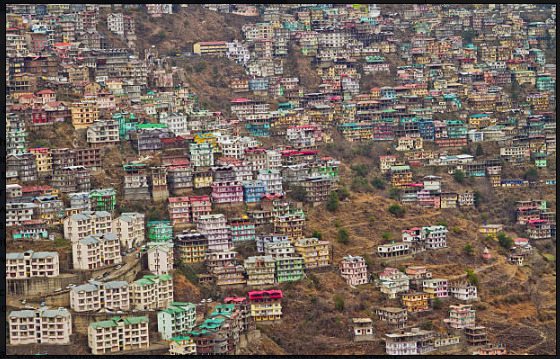Einstein had once famously remarked that the only thing more dangerous than ignorance is arrogance. A surfeit of either is minacious. A mixture of both, however, can be disastrous. The elected government of Himachal is now displaying that it has both attributes in abundance and it is the residents of the state who are paying the price for this uninformed hubris, which is bound to increase exponentially in the years to come. The ignorance is perhaps remediable, but the arrogance of politicians elected for five years and bureaucrats assured of a thirty- year tenure is becoming endemic in our “electoral autocracy”, and can spell disaster for the state.
Notwithstanding the daily visitations of the impacts of climate change, deforestation and global warming in the state, the government is deaf and blind to the pernicious effects of its distorted “development” model on the ecology and livelihoods of its citizens. Huge swathes of local populations and panchayats have been protesting for years against the Jangi-Thopan hydel project in Kinnaur, the so-called international airport in Balh valley of Mandi district, the Kishau dam project in Shimla district, to mention just a few. Even while these agitations continue, the government has decided in its arrogance and ignorance to push ahead with another blunder- the ill thought-out new Development Plan 41 (DP41) for Shimla, which was given Cabinet approval last week and could be notified any day now.
This decision flies in the face of repeated studies and warnings by its own agencies- an EIA by the State Department of Environment (2013), a Comprehensive Disaster Management Plan by the Municipal Corporation Shimla (2012), both of which had advised against relaxing the Town Planning rules. Having already more or less destroyed this once idyllic town, the government is now preparing to administer the death blow- it’s like a murderer returning to the scene of his crime to ensure that the job is well and truly done. And it will be, if the courts allow this to be implemented.
In 2017 the NGT (National Green Tribunal), acting on a petition by an environmentalist, Jogin Sengupta, had appointed an Expert Committee to make recommendations for future town planning and construction in Shimla Planning Area. Unlike most govt. committees this one had professionals from the Wadia Institute, National Disaster Management Authority, Ministry of Environment and Forests, NEERI, among others. It would be relevant to list out here some of the more significant observations/recommendations of this committee:
[1] Shimla falls under seismic Zone IV and this is compounded by the fact that 85% of the town is located in landslide prone zone, that most constructions are on steep slopes with gradients between 45* and 75*, buildings are constructed on overburden rather than on on solid rock, barely 20% of them meet the standards for seismic proof construction.
[2] In the event of an earthquake 39% of the buildings shall collapse, and the cascading effects of falling buildings will have a multiplier effect. More than 20000 people shall be killed. This, says the Committee, is an extremely conservative estimate. “It is evident that Shimla and its surrounding areas face great risk to life and property in case of earthquakes and big landslides.”
[3] The town has long exceeded its carrying capacity and needs to be urgently decongested.
[4] There should be no new construction of any kind or addition to existing facility in the Green Areas, Core areas or Heritage Areas.
[5] There is an urgent need to increase the forest cover of the town, both for reasons of ecology, water conservation and soil stability.
[6] In view of the above findings and observations the Committee recommended that, far from allowing any relaxations, the boundaries of the Green Belt be extended further, and that new No Construction areas be created in the High Sinking/ Landslide Zones such as Lakkar Bazaar, Dhobighat, Ladakhi Mohalla, Krishnanagar and the area surrounding Clarkes Hotel.
The NGT accepted most of these eminently sensible recommendations and, by its order of 2017, imposed a complete ban on any fresh construction in Shimla’s 17 Green Belts and Core Areas, and also restricted construction in the non-core areas to two floors and an attic. The state’s appeal against this order is pending in the Supreme Court, but no stay has been granted. Therefore, it is self evident that the new Development Plan 41 is in violation, if not outright contempt, of the NGT order. ( That the government is not bothered by these minor legalities is explained by the fact that elections to the state are due in December and to the Shimla Municipal Corporation in June this year. And votes matter more than deodars or lives, as we well know by now).

The SDP 41 amounts to driving a coach and four through the NGT order and the report of the Expert Committee. It upturns just about every recommendation and stipulation that could have saved Shimla: construction is now permitted in the Green Belts, the Core and Heritage Areas, a jaw dropping six floors is allowed in the non-core areas, for both commercial and residential buildings. The govt. has completely discarded the scientific findings of the Expert Committee- that every seismologist of any worth has predicted that the Himalayas are overdue for a major earthquake of at least 7.3 magnitude, that Shimla is already in seismic zone IV but moving to V with the destabilisation and deforestation of its slopes, that no vertical growth should be permitted, that a town with a carrying capacity of 25000 population is already overloaded with 225000 people (with an additional 100000 being added during the tourist season), that its roads are wholly inadequate and will not allow rescue operations in the event of any emergency, that its green cover is disappearing at an alarming rate and anthropogenic pressures make natural regeneration of its deodars impossible. Issues about inadequacy of water supply, garbage disposal, climate change- all of which have been flagged by the Committee and the NGT- have been brushed aside with contempt and the arrogance of power.
And this in spite of the fact that the restrictions imposed in 2000 on new constructions were actually working: the census of 2011 established beyond doubt that between 2000 and 2010 the decadal growth in the population of Shimla came down by 50%, serving a key objective of reducing congestion. All this will now be undone.
The new Plan, if allowed to be implemented, will not only lead to a rash of new construction but will also unleash a deluge of applications for the “regularisation” of thousands of illegal buildings constructed since 2000. This process is euphemistically termed “retention policy” and every govt. has taken recourse to it in the past as a vote multiplier- Shimla has had seven retention policies so far, and with each new one the town has moved closer to perdition. It will not survive another one, or the new SDP.
What baffles me, however, is the resounding silence of Shimla’s residents: they are like lambs being led to slaughter (literally, when the next earthquake arrives) but I don’t hear anyone bleating, other than people like Mr. Sengupta who filed the original petition in the NGT. Why are the citizens of this historic settlement not starting a civic movement to force the govt. to back off from this madness? Why are they not making this an election issue for both, the state and municipal elections? Why are they not rallying behind Mr. Sengupta ( who is expending his own resources in this cause) with funding, free legal help and a challenge to the new Plan in the courts? Why is it left to just one or two concerned citizens to protect one of India’s most historic towns from oblivion?
With the executive hell bent on ramming through SDP41, it is now only the High Court or the NGT which can save Shimla. Our courts should not disassociate themselves from such grave public issues: after all, judges too are citizens and residents of this town and shall suffer the consequences of suicidal policies as much as ordinary citizens will. I learn that a young environmentalist and scholar, Richa Minocha, has filed a PIL in the High Court this week for staying this apocalyptic Plan. One fervently hopes that the court will accept this petition and stay the SDP 41. We need more citizens to join and support her. We need the High Court too to bury this Plan beneath the debris of the seven storey building which collapsed in Kachighati last year: that would be the most apt head-stone for a piece of regulation that should never have seen the light of day. To adapt and rephrase the wise words of the historian Arnold Toynbee about civilisations to the present context: Cities do not die of themselves, they are murdered by politicians and town planners.
| The author retired from the IAS in December 2010. A keen environmentalist and trekker he has published a book on high altitude trekking in the Himachal Himalayas: THE TRAILS LESS TRAVELLED.
His second book- SPECTRE OF CHOOR DHAR is a collection of short stories based in Himachal and was published in July 2019. His third book was released in August 2020: POLYTICKS, DEMOCKRAZY AND MUMBO JUMBO is a compilation of satirical and humorous articles on the state of our nation. His fourth book was published on 6th July 2021. Titled INDIA: THE WASTED YEARS , the book is a chronicle of missed opportunities in the last nine years. Shukla’s fifth book – THE DEPUTY COMMISSIONER’S DOG AND OTHER COLLEAGUES- was released on 12th September 2023. It portrays the lighter side of life in the IAS and in Himachal. He writes for various publications and websites on the environment, governance and social issues. He divides his time between Delhi and his cottage in a small village above Shimla. He blogs at http://avayshukla.blogspot.in/ |



People will be great full if these questions can be answered by the Author.
1. What are the basis of Division of Core area and Non Core Area .
2. “Jammu and Kashmir, Ladakh, Himachal Pradesh, Uttarakhand, Sikkim, parts of the Indo-Gangetic plains (North Punjab, Chandigarh, Western Uttar Pradesh, Terai, a major portion of Bihar, North Bengal, the Sundarbans) and the capital of the country Delhi fall in Zone 4. In Maharashtra, the Patan area (Koynanagar) is also in Zone 4.” These all places lie in seismic zone 4 is there such restriction for these places.
3. There are places where Slopes are not at all steep and are not even Landslide prone. Is there any provision for these places.
4. Is it good to hamper the development and livelihood of people on the basis of ill designed method.
5. I think the author should expand the FOV of the image ” Spot the tree ” he will surely find a tree cover .
Navdeep would do well to read the report of the Expert Committee and the order of the NGT, where all these questions are adequately addressed. I would be happy to share them with him if he would share his email ID with me. As far as other places being in seismic zone IV is concerned, it needs to be remembered that the severity of an earthquake depends on the geology of the area, and the geology of the Himalayas ( including Shimla) is quite different from that of Delhi , Maharashtra and other places mentioned by him. Livelihoods are important, but lives are even more so.
The comment above is a uncomfortable reminder of the years before the Kathmandu quake , with geologists in vain warning of what was going to happen , and even denied resources for mapping the most vulnerable areas.